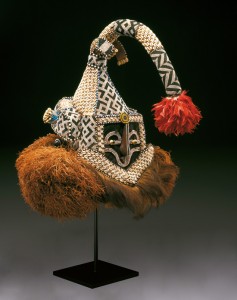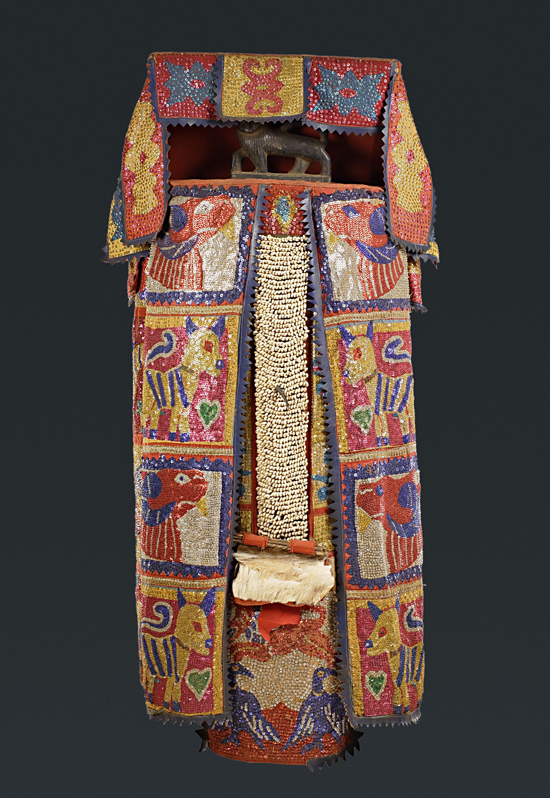There’s a mask in the Dallas Museum of Arts’ African Masks: The Art of Disguise that transfixed me. Compared to the objects surrounding it in this show that features a wide collection of masks and costumes from across the continent, it wasn’t spectacularly ornate, colorful, referential, or animal inspired. The mask — a simple rounded helmet made of wood, beeswax, human hair, and pigment — portrayed a nearly flattened face with slits for eyes and a tiny mouth with its bottom lip dropped in an ambiguous smile that reveals clenched wooden teeth. On the face there are markings, like war paint, zigzagging across the cheeks — a disguise on the disguise. The top of the head is a scrubby mat of real hair.

I was stuck in front of this mask because it seemed to be watching me: staring, taunting, provoking. Even in a staid gallery, surrounded by a great number of fantastic and frightening objects, all pulled from the contexts of their ritualistic function, this little mask seemed to cling to its power. The feeling was unlike the typical experience of art in a museum. Usually your mind wanders about or engages with an object or image, with your senses acted upon for some emotional or intellectual end. Here I felt a strange mix of fear and reverence.
The obvious difference between this and most museum shows is that when you visit African Masks, you peruse objects that are the focal point of spiritual worship. To the exhibition’s credit, a good deal of effort is made to remind you that these religious practices aren’t the forgotten eccentricities of some Bronze Age people, but, in many cases, exercises still performed today (most of the masks in the show are 20th century). Something spiritual seems to remain on some of these pieces, like the soil of Africa stuck in the crevasses of the carved wood. After all, the “art” of these pieces (the aspect of the work that makes them more than craft, decoration, or ornament) resides in the way their forms mysteriously inspire the recognition of some transcendental presence.

There are three ways the DMA’s curation of the show, led by Margaret McDermott curator of African art Roslyn A. Walker, preserves the objects from anonymity and impotence, at least as much as possible given the museum setting. Importantly, the exhibition includes more than just masks, pairing these popular collector’s objects with full dress pieces and other costumes, sometimes outfitting mannequins in full ceremonial regalia that looms large in the gallery space. The ceremonial dresses are also thoughtfully presented, grouped on platforms that show the main characters of a particular tribe’s myths and religious dramas together. Even when the full costumes aren’t present, there are a few displays that show collections of masks from a given people together so that you can see how the forms and styles change depending on the use. This provokes the kind of museum experience most appropriate for this kind of a show – something educational and studied, but also, in a way, dramatized.
There are a number of video screens positioned throughout the space that show documentary footage of the nearby objects being used in ritual dances. The challenge when introducing this kind of documentary material into an exhibition is to determine the balance you want to create between the video and the objects themselves. Here Walker has decided to keep the videos small and sporadic so that they don’t overpower and distract from the objects. It proves an effective choice. The show doesn’t devolve into a gallery-based PBS viewing room, but the videos provide just enough visual information to trigger the imagination of viewer. Turning back to an actual mask, you can more easily imagine it bob, sway, and come alive.

Sometimes exhibitions that provide similar historical reviews segregate the gallery space into rooms, organizing objects and artifacts by era or sub-region. Walker has decided to place them in one large hall, obstructed by only a few partitions. The ultimate effect is that you don’t feel ushered through the space, obligated to keep hold of the historical and cultural information conveyed at each stop along the way. The gallery allows the visitor to twist and turn, to move about freely and approach objects that strike from afar. The masks and costumes can be viewed from a variety of angles and distances, similar to the way they would be encountered in the context of a dance.
During performances, these masks (representing deities, spirits, or ancestors) would approach aggressively, engaging you in a public experience of penitence, contrition, praise, or mortification. We have to settle for approaching these objects ourselves and imagining what a shaking experience it would be to have these sometimes horrifying, sometimes playful, but always arresting visages coming at us.
Main image: Helmet mask (muti wa lipiko), Mozambique and Tanzania, Makonde peoples, before 1914. (All photos courtesy of the Dallas Museum of Art)




